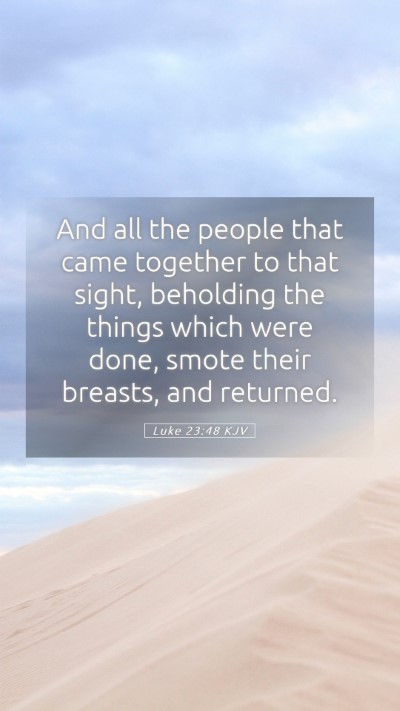Understanding Luke 23:48
Luke 23:48 states: "And all the people that came together to that sight, beholding the things which were done, smote their breasts, and returned." This verse is pivotal as it captures the emotional response of the crowd witnessing the events surrounding the crucifixion of Jesus. In this summary, we will explore the meaning of this verse through insights drawn from public domain commentaries, highlighting various aspects of its significance.
Context of the Verse
Before delving into the detailed interpretations, it is essential to understand the broader context of this passage within the Gospel of Luke. This verse follows the crucifixion of Jesus, a moment filled with profound theological implications. The narrative details the human reaction to the divine sacrifice, and this moment is crucial in grasping the gravity of the event.
Emotional Response of the Crowd
The verse illustrates a collective emotional reaction from the witnesses of the crucifixion. Here are some interpretations:
- Matthew Henry notes that the crowd's action of smiting their breasts signifies deep sorrow and repentance for what they have witnessed. This physical expression reflects their grief and acknowledgment of the gravity of their sins and, by extension, the costs of such a sacrifice.
- Albert Barnes emphasizes that this reaction can be viewed as a call to repentance. The crowd's mourning implies an eventual understanding of who Jesus was and recognition of the seriousness of their actions against Him. The smiting of their breasts signifies an inward reflection that leads to outward expression, suggesting an awakening to their spiritual condition.
- Adam Clarke points out that this moment represents a turning point—a collective recognition among the onlookers, possibly indicating that their hearts were stirred to belief. Their return indicates that they were not merely passive observers but were moved to reflect on their lives and choices.
Theological Implications
This verse carries significant theological messages that resonate throughout Christian doctrine:
- Acknowledgment of Sinfulness: The crowd's action serves as a profound recognition of sin—a crucial step in the journey of faith. Their sorrow indicates an understanding of the necessity of Jesus' sacrifice, as noted in various Bible verse interpretations.
- Foreshadowing of Redemption: The emotional turmoil serves as a foreshadowing of the redemptive work that Jesus accomplishes through His death and resurrection. This moment carries echoes of the call to repentance conveyed throughout the Gospels.
- Power of Witness: This crowd’s reaction highlights the power of witnessing the crucible of faith—the sentiments evoked by observing divine acts can lead to profound transformations in belief and practice.
Application to Daily Life
As readers today, we can extrapolate several lessons from Luke 23:48:
- Self-reflection: Just as the crowd smote their breasts in sorrow, we are encouraged to engage in moments of self-reflection and repentance. Understanding our own shortcomings fosters spiritual growth.
- Response to Christ's Sacrifice: Acknowledging the significance of Christ's sacrifice can invoke a response within us—a call to live a life reflective of His teachings and grace.
- Community in Mourning: Similar to the communal reaction of the crowd, we can find strength and unity in discussing and processing our faith journeys within Bible study groups or online Bible study settings.
Cross References
This verse connects with several other key passages in Scripture that deepen our understanding:
- Matthew 27:51-54: This passage recounts the events just after Jesus’ death, including the earthquake and the temple veil being torn, which are significant in understanding the implications of His sacrifice.
- Luke 18:13: The tax collector's prayer is representative of the humility and repentance seen in the crowd’s response; understanding one's sinfulness is vital for approaching God.
- Acts 2:37: The response of the crowd at Pentecost, wherein they are "pierced to the heart" upon hearing Peter’s message about Jesus, parallels the mourning here in Luke 23:48.
Conclusion
Luke 23:48 serves as a profound reminder of the human capacity for recognition and reflection upon divine truths. Through the insights provided by Matthew Henry, Albert Barnes, and Adam Clarke, we see that the emotional response of the crowd is not just an end but a beginning—a starting point for transformation, repentance, and a deeper understanding of Scripture. As we study this verse, may we also consider our responses to Jesus' sacrifice and reflect on how we can align our lives with the teachings that stem from such significant events.
Further Study
For deeper engagement with this passage and others, consider utilizing various Bible study tools and resources. Engaging with Bible study guides and participating in Bible study groups can enrich your understanding and application of these biblical concepts. These efforts align with the primary aim of seeking clarity on bible verse meanings, scripture analysis, and ongoing biblical exegesis.


